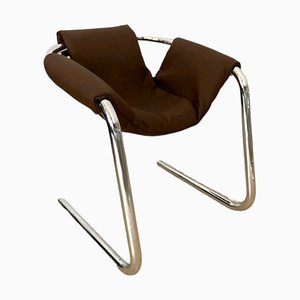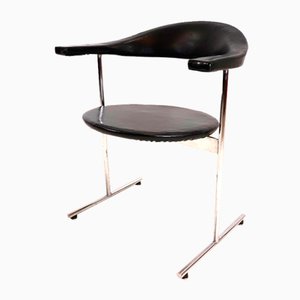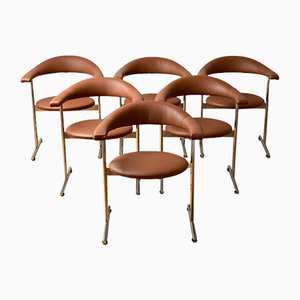
Painter and industrial designer, Geoffrey D. Harcourt was born in 1935 in London, England. As a boy, he attended the High Wycombe Technical School, and subsequently the High Wycombe School of Art, where he gained a National Diploma in Design (NDD) and won a place at the Royal College of Art in London after conscription into the Royal Artillery in 1955. After graduating in 1960, Harcourt traveled to the Chicago in the United States, where he worked in industrial design from 1960 until 1961, before returning to Europe and working with designer Jacob Jensen in Copenhagen.
In 1962 he moved back to England and established his own practice based in Oxfordshire. There, he began designing various seating programs for the Dutch manufacturing brand Artifort. Harcourt played a significant role in Artifort’s successful transition into the contract furniture market. Their collaboration set a precedent for alliances between British designers and foreign companies. The futuristic, boldly-colored seating created from this fruitful partnership became Harcourt’s most well-known work. High demand for Space Age design in the 1960s and 1970s meant Harcourt’s designs for Artifort were met with international success, with many models still in production today. Important designs for Artifort include, 042 Series (1963)—which became Harcourt’s first big success; 500 Series (1967)—including the F 510, F 511, F 584, F 585, and F 587 chairs; F 141 Chair (1967); F 978 Chair (1968); 975 IntermediateChair (1968); Cleopatra Chaise Lounge (1970); and the Chicago Chair and Michigan Chair (both 1971), among many others.
Believing that the chair should focus on the person, Harcourt’s ability to balance clean aesthetics with ergonomics and comfort is a true art form. Harcourt’s maxim, “first the person, then the chair,” is clearly reflected in his designs. Over the course of his career, Harcourt designed for other well-known companies such as, Dynamite Nobel, Trau of Turin, Steelcase Strafor, Gordon Russell, Hands of Wycombe, Ben Dawson, Mines and West, and many more. Notable designs include, the University Halls of Residence Series (1963) for Olivex London; Strathclyde University Assembly Chair (1980), for Ben Dawson Ltd.; Rapport Series (1998) for Hands of Wycombe; and Tandro Chair (originally designed in 1961 and produced in the 2000s) for Emmemobili of Cantu, Italy.
Harcourt’s work has been exhibited at iconic institutions worldwide, such as the Stedelijk Museum in Amsterdam, the Pompidou Centre in Paris, the Prague Museum of Decorative Arts, the Design Council in London and Glasgow, and the Victoria & Albert Museum in London.
Notably, he was awarded the highly prestigious title of “Royal Designer for Industry” (RDI) by the Royal Society for the Encouragement of Arts, Manufactures and Commerce (RSA) in 1978, and has held several esteemed professorships at various academic institutions including his alma mater, the Royal College of Arts in London.
Harcourt retired from furniture design in his seventies, to pursue a passion for painting. Today, he lives in Oxfordshire and continues to paint. His work is representational and reflects a broad interest in his surroundings, including still life subjects and life studies.
* Images courtesy of Artifort






